26 March
lecture series
HOLY WEEK CYCLE
Easter Cinema in Navarre and in the Spain of NO-DO
D. Alberto Cañada Zarranz
Film Archive of Navarre
I would like to thank the Chairde Patrmonio y Arte Navarro for inviting me to prepare this talk, as it means that this Chairconsiders film art as part of the Heritage.
It has been difficult to find traces of the ceremonial acts typical of these dates in the cinema. And when I refer to cinema, I am talking about that subjectof films that were filmed on plastic support (commonly known as celluloid), destined to be consumed in cinemas. The digital universe and video cameras accessible to everyone have facilitated the proliferation of amateur or amateur records, but there are still no edited films (professional or semi-professional) that include scenes of Holy Week in Navarre.
However, in spite of this, I have found vestiges, testimonies that have allowed scenes of Holy Week in Navarre to be preserved on film. As a complement, and to remind us what the Easter Week processions of the last century were like, as some of you will remember them, and not very different from those of today (because this is something that has not changed much: the pasos, the protagonists of the parades, the ceremony, etc.). But in the rest of Spain, we will remember the Holy Week filmed by NO-DO.
Holy Week cinema in Navarre
The first thing we are going to see are some scenes corresponding to Holy Week in Tudela, specifically of the Volatín and La bajada del ángel. They are shots filmed by Antonio Tramullas in the mid-1920s, probably around 1923. The Volatín (staging of the hanging of Judas) takes place on Holy Saturday and The Descent of the Angel takes place on Easter Sunday. This event was again captured by professional film cameras in the documentary Navarra: las cuatro estaciones (1970-72), by the Caro Baroja brothers (Julio and Pío). We therefore also see these images, to try to appreciate whether there were changes in both the ceremony and the people attending it.
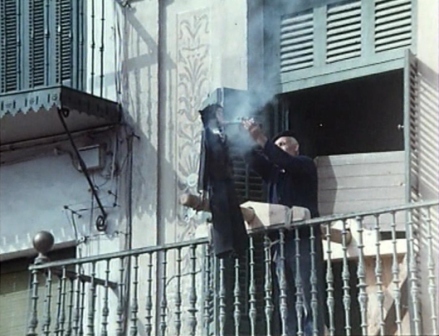
The Tudela volatín
(Still from Navarre. The four seasonsby Pío Caro Baroja, 1971)
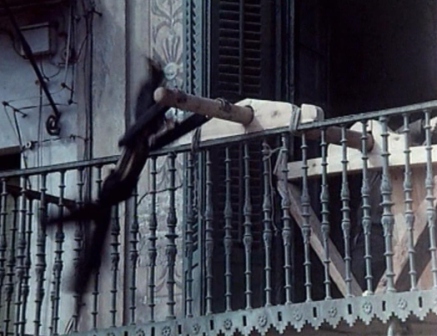
The Tudela volatín
(Still from Navarre. The Four Seasons, by Pío Caro Baroja, 1971)
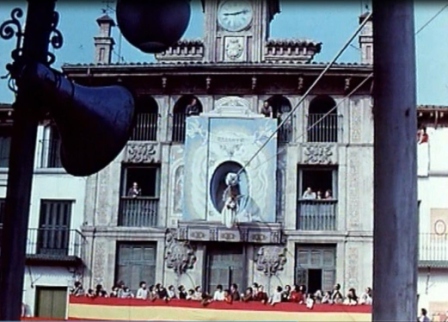
The Descent of the Angel of Tudela
(Still from Navarre. The Four Seasons, by Pío Caro Baroja, 1971)
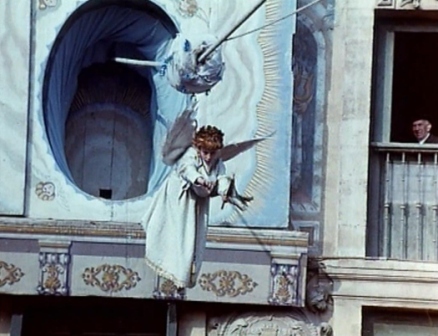
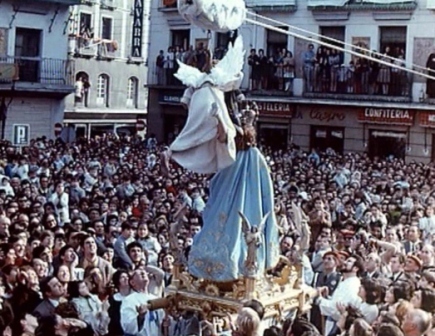
The Descent of the Angel of Tudela
(Stills from Navarre. The Four Seasons, by Pío Caro Baroja, 1971)
We change celebration and place; we go to the north to remember another of the folkloric manifestations of Easter in Navarre. This is the Volantes de Valcarlos, who dance on Easter Sunday. This act was also featured in the documentary Navarra: las cuatro estaciones (Navarre: The Four Seasons). We can also find a staging of this dance in an unclassifiable film (it is neither fiction nor documentary, but quite the opposite; a kind of promotional film of Navarre under the guise of a film with a plot). Its degree scroll: quotation in Navarre, filmed in 1966 under the orders of José Grañena, with a script by Jaime del Burgo, starring Manuel de Blas and Patty Shepard.
And we return to the south of Navarre, specifically to Villafranca and Corella, where the documentary Navarra: las cuatro estaciones reconstructs a tradition of these dates: "Los dormidos", a theatrical performance that still survives. In addition, interspersed with scenes from the procession in Corella.
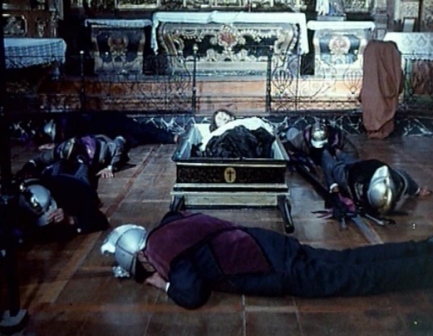
"Los dormidos" of Villafranca
(Still from Navarre. The Four Seasons, by Pío Caro Baroja, 1971)
Holy Week in NO-DO's Spain
The NO-DO archives contain almost 300 newsreels with footage of Holy Week. It was one of the most important celebrations in the religious calendar, and generally and punctually every year the cameras of this newsreel travelled to various Spanish cities to film their processions. They never came to Pamplona. However, I wanted to rescue some of those scenes, because the atmosphere in the streets of these Spanish cities was similar to the one here.
The fragments corresponding to Holy Week from the following NO-DO are shown:
1. NO-DO nº XVIII (1943). First Holy Week in NO-DO.
2. NO-DO nº LXVIII (1944). Holy Week in Malaga and Seville.
3. NO-DO no. MCCLXV (1967). Holy Week in La Alberca (Salamanca).
4. NO-DO nº MDCLXXX (1975). Last NO-DO Easter Week before the death of F. Franco. Montoro (Cordoba)
5. NO-DO MDCCLXXXIV (1977). Last Holy Week on NO-DO. Córdoba.
In this way you will be able to appreciate the evolution of Easter Week in Spain in little more than 40 years. I invite you to pay attention to the voice-over, you will notice how the speechchanges from 1943 to 1977.
End
And once you have seen this, reservationhas a little surprise for you. It is a brief approach to the recent but distant Semana Santa in Pamplona. We watch a summaryof a recent documentary on Easter Week in Pamplona (Colombia), a sister city where this celebration is celebrated with great fervour. We take the opportunity to discover part of the physiognomy of the city of the same name.
